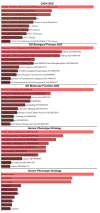Cancer Associated PRDM9: Implications for Linking Genomic Instability and Meiotic Recombination
- PMID: 38003713
- PMCID: PMC10671843
- DOI: 10.3390/ijms242216522
Cancer Associated PRDM9: Implications for Linking Genomic Instability and Meiotic Recombination
Abstract
The PR domain-containing 9 or PRDM9 is a gene recognized for its fundamental role in meiosis, a process essential for forming reproductive cells. Recent findings have implicated alterations in the PRDM9, particularly its zinc finger motifs, in the onset and progression of cancer. This association is manifested through genomic instability and the misregulation of genes critical to cell growth, proliferation, and differentiation. In our comprehensive study, we harnessed advanced bioinformatic mining tools to delve deep into the intricate relationship between PRDM9F and cancer. We analyzed 136,752 breakpoints and found an undeniable association between specific PRDM9 motifs and the occurrence of double-strand breaks, a phenomenon evidenced in every cancer profile examined. Utilizing R statistical querying and the Regioner package, 55 unique sequence variations of PRDM9 were statistically correlated with cancer, from a pool of 1024 variations. A robust analysis using the Enrichr tool revealed prominent associations with various cancer types. Moreover, connections were noted with specific phenotypic conditions and molecular functions, underlining the pervasive influence of PRDM9 variations in the biological spectrum. The Reactome tool identified 25 significant pathways associated with cancer, offering insights into the mechanistic underpinnings linking PRDM9 to cancer progression. This detailed analysis not only confirms the pivotal role of PRDM9 in cancer development, but also unveils a complex network of biological processes influenced by its variations. The insights gained lay a solid foundation for future research aimed at deciphering the mechanistic pathways of PRDM9, offering prospects for targeted interventions and innovative therapeutic approaches in cancer management.
Keywords: PRDM9; breast cancer; carcinogenesis; head and neck cancer; lung adenocarcinoma; ovarian cancer; permutation analysis R; recombination; sequence motif.
Conflict of interest statement
The authors declare no conflict of interest.
Figures





Similar articles
-
Aberrant PRDM9 expression impacts the pan-cancer genomic landscape.Genome Res. 2018 Nov;28(11):1611-1620. doi: 10.1101/gr.231696.117. Epub 2018 Oct 19. Genome Res. 2018. PMID: 30341163 Free PMC article.
-
ZCWPW1 is recruited to recombination hotspots by PRDM9 and is essential for meiotic double strand break repair.Elife. 2020 Aug 3;9:e53392. doi: 10.7554/eLife.53392. Elife. 2020. PMID: 32744506 Free PMC article.
-
The Meiotic Recombination Activator PRDM9 Trimethylates Both H3K36 and H3K4 at Recombination Hotspots In Vivo.PLoS Genet. 2016 Jun 30;12(6):e1006146. doi: 10.1371/journal.pgen.1006146. eCollection 2016 Jun. PLoS Genet. 2016. PMID: 27362481 Free PMC article.
-
PRDM9, a driver of the genetic map.PLoS Genet. 2018 Aug 30;14(8):e1007479. doi: 10.1371/journal.pgen.1007479. eCollection 2018 Aug. PLoS Genet. 2018. PMID: 30161134 Free PMC article. Review.
-
PRDM9 and Its Role in Genetic Recombination.Trends Genet. 2018 Apr;34(4):291-300. doi: 10.1016/j.tig.2017.12.017. Epub 2018 Jan 21. Trends Genet. 2018. PMID: 29366606 Free PMC article. Review.
Cited by
-
Exploring Meiotic Recombination and Its Potential Benefits in South African Beef Cattle: A Review.Vet Sci. 2025 Jul 16;12(7):669. doi: 10.3390/vetsci12070669. Vet Sci. 2025. PMID: 40711329 Free PMC article. Review.
-
Epigenetic Modifiers: Exploring the Roles of Histone Methyltransferases and Demethylases in Cancer and Neurodegeneration.Biology (Basel). 2024 Dec 3;13(12):1008. doi: 10.3390/biology13121008. Biology (Basel). 2024. PMID: 39765675 Free PMC article. Review.
References
MeSH terms
Substances
Grants and funding
LinkOut - more resources
Full Text Sources
Medical
Molecular Biology Databases
Research Materials

